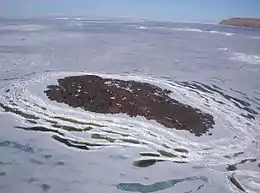Ruin Island
Ruin Island is a small island off the coast of the Inglefield Land region of northwest Greenland. In the 1930s, Danish archaeologist Erik Holtved discovered the remains of human habitation on the island. The culture associated with this archaeological site became known as the Ruin Island phase of Thule Culture.[1] Items traded by the Greenlandic Norse travelled as far as Ruin Island.[2]
 Ruin Island with Cape Russell in Background | |
 Ruin Island Ruin Island (Greenland) | |
| Geography | |
|---|---|
| Location | Greenland |
| Coordinates | 78°52.1′N 69°11.3′W |
| Administration | |
Greenland | |
History
The earliest known inhabitants of Ruin Island are ancestors of the Inuit known as Thule culture, named after the nearby archeologic site of Thule. These Thule culture inhabitants have been estimated to arrive at Ruin Island between 1280 and 1330.[3]
References
- Archaeology of Prehistoric Native America: An Encyclopedia. Gibbon, Guy E. and Kenneth M. Ames. 1998
- Inuit-Norse contact in the Smith Sound region/Schledermann, P. McCullough, K.M.
- The Northern World: AD 900–1400. Edited by Herbert Maschner, Owen Mason, and Robert McGhee. 2009
This article is issued from Wikipedia. The text is licensed under Creative Commons - Attribution - Sharealike. Additional terms may apply for the media files.